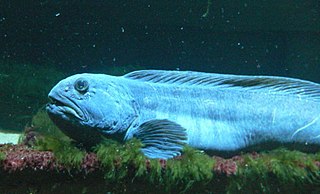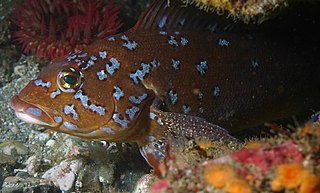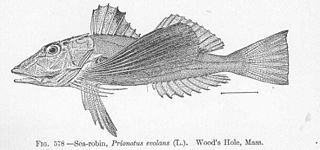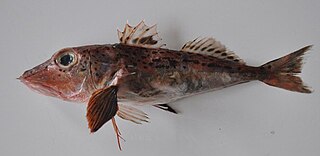
Triglidae, commonly known as gurnards or sea robins, are a family of bottom-feeding scorpaeniform ray-finned fish. The gurnards are distributed in temperate and tropical seas worldwide.

Congiopodidae, commonly known as pigfishes, horsefishes and racehorses, is a family of ray-finned fish classified with in the order Scorpaeniformes. These fishes are native to the Southern Hemisphere.

Anarhichadidae, the wolffishes, sea wolves or wolf eels, is a family of marine ray finned fishes belonging to the order Scorpaeniformes. These are predatory, eel shaped fishes which are native to the cold waters of the Arctic, North Pacific and North Atlantic Oceans.

Pholidae is a family of marine ray-finned fishes, known as gunnels, in the scorpaeniform suborder Zoarcoidei. These are fishes of the littoral zone and are mainly found in North Pacific Ocean, with two species found in the North Atlantic Ocean and Arctic Ocean.

Peristediidae, the armored sea robins or armoured gurnards, is a family of ray-finned fishes belonging to the suborder Platycephaloidei in the order Scorpaeniformes. They are found in the deep water in the tropical and warm temperate of the world's oceans.
The spotted gurnard is a species of ray-finned fish belonging to the family Triglidae, the gurnards and sea robins. This fish is found in the eastern Pacific Ocean. Its length is up to 35 cm.

The Platycephalidae are a family of marine fish, most commonly referred to as flatheads. They are relatives of the popular lionfish, belonging to the order Scorpaeniformes.

Chelidonichthys, the smallscaled gurnards, is a genus of marine ray-finned fishes belonging to the family Triglidae, the gurnards and sea robins. These gurnards are found in the Eastern Atlantic, Indian and Western Pacific Oceans.

Lepidotrigla is a genus of marine ray-finned fishes belonging to the family Triglidae, the gurnards and sea robins. These gurnards are found in the Eastern Atlantic, Indian and Western Pacific Oceans.

Pterygotrigla is a genus of genus of marine ray-finned fishes belonging to the family Triglidae, the gurnards and sea robins, one of two genera belonging to the subfamily Pterygotriglinae. These gurnards are found in the Indian and Pacific oceans.

Platycephaloidei is a suborder of ray-finned fishes, part of the order Scorpaeniformes, and includes the flatheads, ghost flatheads and sea robins.

Hexagrammos is a genus of marine ray-finned fishes belonging to the family Hexagrammidae, the greenlings. These fishes are found in the north Pacific Ocean.

Hoplichthys, the ghost flatheads, is a genus of marine ray-finned fishes native to the Indian and Pacific Oceans. This genus is the only member of the family Hoplichthyidae.

Neosebastinae, the gurnard scorpionfishes or gurnard perches, is a small subfamily of deep-sea ray-finned fishes, it is part of the family Scorpaenidae. These fishes are found in the Indian and Pacific oceans. Several of the species in this family are venomous.
Bovitrigla is a monotypic genus of marine ray-finned fishes belonging to the family Triglidae, the gurnards and sea robins, one of two genera belonging to the subfamily Pterygotriglinae. Its only species, Bovitrigla acanthomoplate, is found in the western Pacific Ocean.

Prionotinae is a subfamily of demersal, marine ray-finned fishes, part of the family Triglidae. The fishes in this subfamily are called sea robins and are found in the Western Atlantic and Eastern Pacific Oceans, the other two Triglid subfamilies are called gurnards.

Triglinae is a subfamily of demersal, marine ray-finned fishes, part of the family Triglidae, the gurnards and searobins. These gurnards are found in all the tropical and temperate oceans of the world except for the Western Atlantic Ocean.

Pterygotrigla polyommata, the latchet, butterfly gurnard, flying gurnard, lachet gurnard, pastry, sharpbeak gurnard, spiny gurnard or spinybeak gurnard, is a species of marine ray-finned fish belonging to the family Triglidae, the gurnards and sea robins. It is found in the southeastern Indian and southwestern Pacific Oceans.

The blackspotted gurnard, also known as the half-spotted gurnard, is a species of marine ray-finned fish belonging to the family Triglidae, the gurnards and sea robins. It is found in the Indo-Pacific region.
Gymnelinae is a subfamily of marine ray-finned fish belonging to the family Zoarcidae, the eelpouts. Most species are found in the North Pacific Ocean but one genus is cosmopolitan, and another is endemic to the Southern Ocean.















